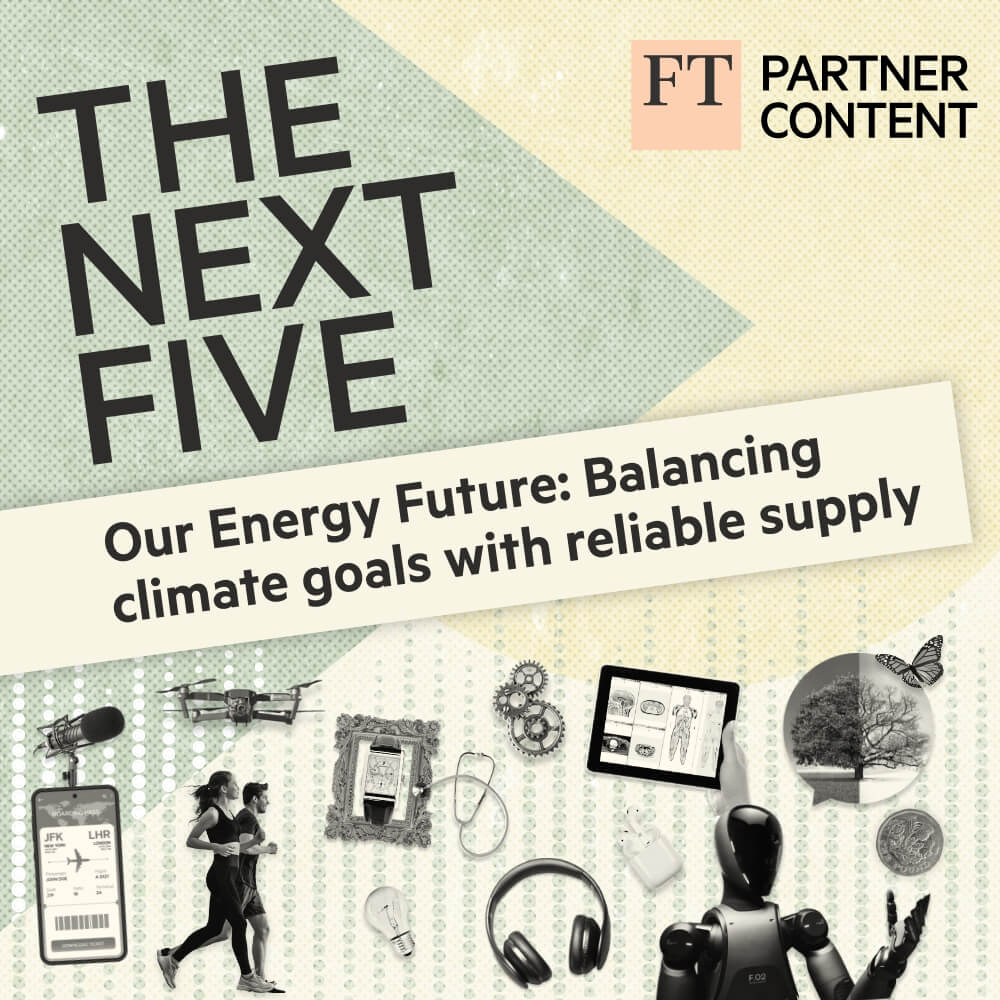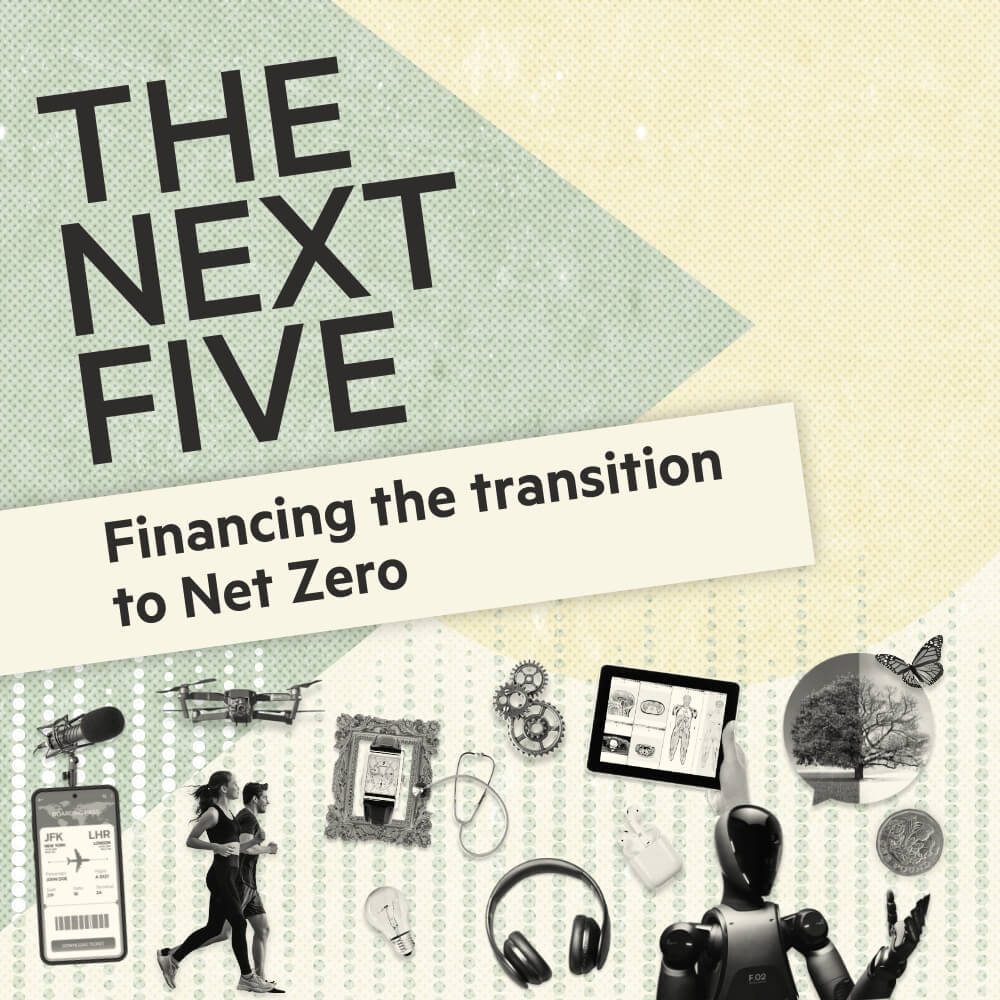THE NEXT FIVE
THE NEXT FIVE - EPISODE 4
The Future of Energy
Future energy technologies like fusion and hydrogen promise to be ‘game changers’ that could power our world and fuel our future.






































The Next Five is the FT’s partner-supported podcast, exploring the future of industries through expert insights and thought-provoking discussions with host, Tom Parker. Each episode brings together leading voices to analyse the trends, innovations, challenges and opportunities shaping the next five years in business, geo politics, technology, health and lifestyle.
















Featured in this episode:
Tom Parker
Executive Producer & Presenter
Bob Mumgaard
CEO of Commonwealth Fusion Systems
Kevin Eggers
Founding partner of AP Ventures
Lisa Rebora
Senior Vice President of Emerging and Future Business at Equinor
Future energy technologies like fusion and hydrogen promise to be ‘game changers’ that could power our world and fuel our future.
Both solutions have been talked about for decades yet remain just out of our grasp - but for how long? The world is shifting: a record amount of capital was pledged to renewable energy projects in 2021. However, current renewables like wind and solar can’t get us all the way to net zero while decarbonising carbon heavy sectors. Therefore, inventing, innovating and investing in future low carbon energy solutions such as fusion and hydrogen is key to success. But getting new technologies to commercial scale in time will require rapid collaboration on a global scale. So, what does the future of energy look like and what will the next five years hold? Here to help navigate the topic are a series of industry experts. Bob Mumgaard, CEO of Commonwealth Fusion Systems joins to extol the exciting potential of fusion energy, and what the technology means for the future of human development. Founding partner of AP Ventures, Kevin Eggers explains how to unlock the hydrogen economy and Lisa Rebora, Senior Vice President of Emerging and Future Business at Equinor discusses how to fund, support and foster future solutions.
Show sources and credits: FT resources, UNFCCC, Politics and Prose Bookstore, The US State Department (DOE), BloombergNEF, ITER, CSPAN, IEA, UK Government. All soundbites used with permission.
This content is paid for by Equinor and is produced in partnership with the Financial Times' Commercial Department.
READ TRANSCRIPT
- Climate
- Finance
Transcript
The Future of Energy
David Attenborough 00:02
A new industrial revolution, powered by millions of sustainable innovations is essential, and is indeed, already beginning.
Tom Parker 00:13
Sir David Attenborough, in his opening speech at COP 26, outlined the urgent need to invest in clean green technologies to combat climate change, and meet the world's future energy demands. Luckily, he's not alone,
Joe Biden 00:29
we need to move rapidly to the new technologies, clean hydrogen, long duration, energy storage, nuclear
Tom Parker 00:36
heads of states want it, the time for words has now moved to the time for action, and the financial world is ready for it. Make no mistake, the money is here. But this is nothing new, the science, the agenda, and the money is all pointing in the same direction now is the speed of deployment that matters. It's one minute to midnight on that doomsday clock, and we need to act now. I'm Tom Parker, and welcome to the next five podcast brought to you by the FT partners studio. In this series, we ask industry experts about how their world will change in the next five years, and the impact it will have on our day to day. In this episode, we're focusing on future energy technologies, specifically to different but promising climate solutions. And I'll be speaking to some of those driving this new industrial revolution. And with it the race to net zero
Bob Mumgaard 01:39
repair on we could turn it off, we could put it anywhere in the world. That's a game changer. Fusion is the energy process that occurs inside the stars. It's the process that occurs inside our Sun.
Tom Parker 01:55
This is Bob Mangart, CEO of Commonwealth fusion systems, just one of the cutting edge companies that are trying to commercialise fusion as an energy form.
Bob Mumgaard 02:05
And in that process, it combines light elements to make heavier elements and releases tremendous amounts of energy, about 200 million times more energy per reaction than say burning something. And fusion, although we know it works, because we know how the stars work, we haven't yet harnessed it on Earth. But if we were able to do that, and basically build a miniature star on earth, he would have immense benefits.
Tom Parker 02:30
That light element Bob talks about is hydrogen, one of the most abundant elements in our universe.
Bob Mumgaard 02:40
If you took the type of hydrogen, that's seawater, which is one out of every 6000 hydrogens and you condensed it down, it'll fit in about a glass of water, or maybe a little bigger like a bottle. And that would power everything that a Western person their entire sort of energy footprint their entire life. And that's drastically different, about 200 million times different than the amount of coal, you'd have to dig up to power that life.
US Agency archive film clip 03:05
Every promising source is being explored
Tom Parker 03:08
for ambitions to achieve fusion, and nothing new. This is a clip from a US Agency report in 1978.
US Agency archive film clip 03:16
In the complex field of nuclear reactions, with a promise of power that is truly limitless.
Bob Mumgaard 03:24
So fusion has been seen as an attractive energy source. Basically, since we discovered how the stars worked. 100 years ago, people said, Oh, well, if we could get that process on Earth, that would be a game changer. And fusion has a bunch of unique attributes. First, is not consuming a resource. Almost all energy sources a day are about a resource, whether that's what's underneath our feet, or what shines on us or blows over us. But fusion, there's no resource, it comes out of seawater, everyone has access to it, it does not matter where you are, no one can tell you not to do it. And instead, it's like a machine. That's also something that you can turn on and off and make a lot of power in a small space, which is different from renewables. If you know how to build this machine, you get energy and that is like energy as a technology instead of energy as a resource. That's a big powerful thing for not just climate change, but for human development.
Tom Parker 04:14
Hydrogen also has a role to play elsewhere in a very different way. By curbing emissions from hard to abate sectors that rely on carbon heavy fuel sources. Kevin Eggers is a founding partner of AP ventures, a dedicated venture capital fund that invests in early stage technologies that work along every part of the hydrogen value chain.
Kevin Eggers 04:39
I think firstly, what makes hydrogen really interesting is its versatility and flexibility in those sectors which are hard to electrify and hard to abate and reduce carbon emissions. Hydrogen plays a really interesting role there to the direct reduction of iron ore in decarbonizing aviation, decarbonizing existing ammonia applications, such as fertiliser, or it can be used directly on pollution or trucking into a fuel cell to drive transportation. So I think hydrogen has a significant role to play in heavy duty transportation, including shipping and rail. And those sectors are very difficult to electrify. It couples well with renewable energy, wind and solar. And I think with that the ability to ultimately transform those hard to vote sectors, but
Tom Parker 05:21
Again, this is no new discussion. There is a new energy regime on the horizon. You can almost smell it, you can feel it. You can. It's just there waiting. And it's hydrogen. That was American writer Jeremy Rifkin back in 2002. Speaking ahead of the launch of his book called The hydrogen economy, Rifkin prophesized hydrogen to be the next great economic revolution, and the key to a cleaner, safer and more sustainable world. Indeed, the potential is there. Unlike fusion technology that is still in development, a commercial hydrogen industry already exists. In 2020. Demand for hydrogen was roughly 90 Mega tonnes, and the industry as of 2021, is worth $125 billion dollars. But aren't we close to a hydrogen economy today? As Rifkin predicted,
Kevin Eggers 06:16
we know we can produce it, we know there's a number of sectors that can consume it. But linking a and b is the fundamental challenge of the hydrogen economy. How do we get hydrogen from Morocco into Germany? How do we get hydrogen from the Middle East into Europe, and therefore solving the administration's key? So we're looking at various forms of production. We are very interested in the midstream, including liquid organic hydrogen carriers, ammonia. In many respects, that's the missing link in the hydrogen economy. We think only solving this in the whole looking at that holistic view, can you really bring about a hydrogen economy and thereby causes sort of snowball effect to bring hydrogen into that mainstream
Tom Parker 06:55
conversations around how we fund the world's move to net zero have become more mainstream in recent years. In 2019, when the UK and Italy assumed the office of president, there was about $5 trillion of private financial assets committed to net zero goals. But just two years later, at COP 26, Mark Carney, the UN special envoy on climate action and finance, declared a watershed moment.
07:25
And as you've heard today, over 450, major financial institutions from 45 countries are committing to manage their balance sheets, balance sheets, the total over $130 trillion in line with net zero, so make no mistake, the money is here.
Tom Parker 07:41
Indeed, the money is here. Global investment in renewable energy projects and companies reached a record high in the first half of 2021, totaling $174 billion.
Kevin Eggers 07:55
I believe that private investment will play a considerable role, we are starting with technology. And I think that's interesting, because these are tomorrow's technologies that we can invest in today. With the right incentives and motivation. I'm seeing an increasing amount of capital coalescing around these early stage technologies, with companies' investment funds coming around this belief that these technologies will play a major role in solving this energy transition. And with that, also an opportunity to make money, there's really no point in investing in technology that can't look after itself and ultimately create a return for its investors. So that's fundamental to any technology investment. And that's how we see it, we want to back technology that's going to play a meaningful role and can earn shareholders an outsized return in their future.
Lisa Rebora 08:39
Without a doubt, I think hydrogen is really important in this energy mix going forward.
Tom Parker 08:45
This is Lisa Bohra, Senior Vice President of emerging and future business at Equinor, a broad energy producer and provider that for 50 years has predominantly been involved in oil and gas exploration. But for the last 20 years, there's been a pioneer in floating offshore wind, carbon capture and storage and other renewable solutions.
Lisa Rebora 09:05
I'm really interested in the role of hydrogen together with renewables either as backup and storage, offering flexibility to the renewable baseload when the wind doesn't blow and the sun doesn't shine.
Tom Parker 09:19
Today. Equinor is a venture fund that has invested in both AP ventures and Commonwealth fusion systems.
Lisa Rebora 09:27
We have our investment through the dedicated AP venture, the hydrogen fund. And this is giving us great exposure and strategic insight to multiple startups all working within the hydrogen space. So on the Equinor side, we're working closely with our colleagues working on the hydrogen projects, and really trying to understand what their biggest challenges are, as they're developing these projects. And then there's fusion. This is really an exciting technology. But I love the message around these startups and the whole private equity that's gone into fusion of late because you had these massive government projects that have been running for decades. And they're looking at very big solutions that are complex. And you know, where the startups are coming in is that very agile, experimental mentality failing fast, but consequently delivering something that could be scalable in the future. And, for me, fusion is one of the most exciting technologies out there. And I think these breakthroughs we've seen in the last year or so are because of the investment in the private sector. And because of these smaller companies, or working commonly, towards commercialising fusion in the 2030s. But actually, it only matters if you can create an energy system from it, and you can get it into the market and deploy this
Bill Gates 11:03
division is very exciting. It's very difficult to do breakthrough energies put money into the MIT related one called Commonwealth fusion systems.
Tom Parker 11:13
This is Bill Gates talking in 2019.
Bill Gates 11:16
That technologically is very, very difficult. No one has gotten to so-called energy breakeven, where you have to create 10 million degrees of temperature in order for this fusion to take place. And so to do that, economically, and get net power output is a huge scientific challenge. It definitely should be funded. But unlike fission, that's very straightforward engineering to build that next generation doesn't require invention, fusion requires a lot of invention.
Tom Parker 11:47
But that was nearly three years ago. Today, we're already a lot closer to solving the fusion challenge.
Bob Mumgaard 11:55
And we're sitting here about a factor of two lower than where we needed to be, we've gone a factor of 13 zeros 13 orders of magnitude since we started. But we're a factor of two away from that actual process, creating more heat out than it took to heat it up. And that's the big hurdle that CFS is trying to get across. Money, of course, fuels a lot of things. But in addition to that, there's still plenty of innovation to do, we have a pretty good idea of what we could build today, the more we innovate, the better that's going to be and if we can continue to build that flywheel of innovation, that's a really big deal. That's more than just one company that is in other companies that might not be wanting to build fusion power plants, but might be a part of that ecosystem in the future. And so if we can continue to build innovation and those areas, whether that's materials that withstand the environment inside the fusion power plant, or subsystems that keep it cool and heat up the plasma, or maintenance scenarios that we find the right ways to be able to maintain these plants and ecologically as benign as possible way,
Tom Parker 12:59
investor interest in fusion technology has been growing in recent years. 18 Fusion startups received nearly $2 billion of private investment last year alone, ITER, a fusion project based in France, hailed as the world's most expensive science experiment ever, will be funded to the tune of $25 billion. But while capital is pouring in quicker than ever, accelerating deployment takes more than money.
Prince Charles 13:29
We know from the pandemic, that the private sector can speed up timelines dramatically when everyone agrees on the urgency and the direction. So each sector needs a clear strategy to speed up the process of getting innovations to market,
Tom Parker 13:47
This need to accelerate and hit the climate goals means cutting down the learning time. And that's where collaboration comes in.
Bob Mumgaard 13:57
Because we're building a machine. And that is something the world already knows how to do at scale. That's something that other industries, oil and gas and energy and aerospace are very, very good at. We can learn from all that we don't have to reinvent all that in order to make a fusion industry work, which is one of the reasons that we think it can go much faster than, say , starting over with a completely novel technology. The end of the day fusion is about building machines. They're specialised machines, but we build lots of machines globally,
Lisa Rebora 14:26
developing new industrial value chains and technologies requires so much more than capital. And I strongly believe that when we start working together with these startups and bringing together those complementary skills, we can really accelerate the energy transition. So for Equinor we're working really closely with CFS and in fact, other early phase technologies, but we're bringing operational experience, we bring the whole concept of safety by design, and then there's the institute analysing risk management in the development of projects. So not least, you know, when you put all these experts and competencies together with decades of oil and gas production, with expertise in building clean offshore wind projects, you bring the synergy of skills together that can really accelerate the commercialization of the solutions. To give you an example, there's applications from our LNG value chain. So, cryogenic expertise, you know, we're we're looking at how to cool and liquefy gas that's very relevant in how to call super high temperature magnets, and all of the funding and investment around material science and plasma physics, digital operation that can really accelerate pace of deploying really exciting technologies like fusion,
Tom Parker 15:55
so the money is there, and the industry collaboration is there. The last part is government support. 2020 was a record year for policy action in the hydrogen space, with 10 countries adopting hydrogen strategies, with the aim of stimulating demand and de-risking investment as of September 2021. For more countries, including the UK inked hydrogen policies, and a further 20 announced they're developing theirs. However, without stronger policy action, a commercial low carbon hydrogen economy won't arrive at the pace necessary to meet climate goals.
Lisa Rebora 16:37
Bringing more clean and affordable energy into the markets at an accelerated pace is going to be really important, we need to shorten the time it takes to deploy new solutions and technologies at scale, if we're going to speed up the energy transition, as well as a political push and carbon price incentives.
Tom Parker 16:58
Currently, almost 80% of hydrogen is produced from fossil fuels, resulting in 900 megatons of co2 per year. And this comes down to cost producing low carbon or green hydrogen is pricier at present than fossil fuel based hydrogen. Fortunately, some governments are looking to implement carbon pricing to close this gap and facilitate the adoption of low carbon hydrogen. Anyway, back to Lisa,
Lisa Rebora 17:26
We need to invest in technology and knowledge, and we have to build competence. And to do this efficiently and at lower costs, and really drive this commercially, is going to be crucial. Equinor is developing several major industrial hubs, hydrogen hubs with partners across northwest Europe, both in low carbon, blue hydrogen, and zero carbon, green hydrogen. And they're going to require significant investment. This is large infrastructure, where we're building new markets and new customers at the same time, and those customers don't exist today. So if we're going to do this rapidly, we absolutely need to work with industrial partners and governments together,
Kevin Eggers 18:17
The legislative agenda sets the tone sets the commitments made by governments, and around that businesses and investment institutions like ourselves can coalesce and put capital to work. So certainty on the future is critical. And never before have we seen industries asking to be legislated and governed and regulated as we seek now. And that's really interesting. I think we all recognise we had this huge moment of transition in the energy systems and energy markets. And companies are crying out for that regulation. So that's the starting point.
Tom Parker 18:48
In 1979, President Carter installed solar panels on the roof of the White House, but just two years later, Ronald Reagan removed them. It was 29 years before solar panels were back atop the roofs of 1600. Pennsylvania Avenue, this time under Obama's request. While this isn't policy, it reflects what happens when power changes at the top. And that's just one government. This is a global effort. Therefore, consistency is fundamental.
Lisa Rebora 19:22
So we need to work together closer than ever before, to deliver on the climate targets. We need that regulatory framework and predictability around that if we're going to scale up investment and build businesses. It's important for the risks. It's important to incentivize investments, but it's also important for the customers, they are investing in these technologies themselves. So there's that dimension, which will be really important going forward, then I think there's this global and regional context and how we can work out across countries, and orders and how governments can work together on everything from carbon pricing to infrastructure, to the actual grid distribution and the connectivity across these borders. I mean, that's really going to allow affordable, reliable, clean energy at the end of the day. And this is not something that industries can do alone. We need governments, we need to work together on those. And I think this kind of collaboration is what's going to change the energy systems that we know today,
Tom Parker 20:35
We've come a long way already. In 2022, the amount of energy produced from renewables will account for half of the world's energy demand. By 2026, global renewable electricity capacity is forecast to match the current capacity of fossil fuels and nuclear combined. This is due to stronger government policies, and ambitious clean energy goals announced before and during cop 26. However, according to the International Energy Agency, we're still falling well short of what is required to meet net zero emissions. By mid century, the rate of growth in renewable power capacity must double by 2026, to meet that target. And renewable heat demand needs to be three times higher. So with that in mind, what needs to be done in the next five years,
Lisa Rebora 21:30
I think the next five to 10 years are going to be absolutely critical. We are going to have to work extremely hard at scaling and growing these low carbon solutions and renewables at quite a tremendous pace. The majority of governments and industries, they've all gone out and pledged and committed to cut emissions. So there's no doubt there's a great sense of urgency. But you know, we know technology can be a long game. And if you look over history, energy transitions have taken decades. So it's really coming together to implement those technologies even faster, that's going to make a difference. And I think we're going to see how new global energy systems develop. There's big challenges in power and transport in hydrogen, yo and CCS. And then there's the offsets the natural carbon sinks, products like green fuels, alternative energies, like nuclear. In fact, I think the whole energy mix has to emerge and scale in the next five to 10 years and become commercial. So we're going to need policy and incentives, if we're really going to play out that broad mix of energy solutions. And then there's certainly new technologies, technologies that haven't even been invented today. And they're going to be important in the future. And alongside those, we've got to keep developing the technologies that are already in the marketplace, bring them into new markets and new geographies. That's what scaling is all about. And I think this portfolio of options, you know, assuming that not everything will succeed, because it won't, flaying a broad mix of solutions where you learn and adapt, and you deploy, and then you scale. So the faster we can get out of this technology, the faster we can start to address the climate footprint. In the next five years, for me, it's going to be the most exciting and potentially the most volatile in the energy sector. But it's, it's actually going to be the most rewarding time to be in this industry. We get to contribute to new solutions, and we get to make a difference. I'm really looking forward to it.
Kevin Eggers 23:49
I think we are standing really on a you know, once in a generation shift, and the next two to three years of that five are going to be the most important. From our perspective, it's about investing in the technology advancements we need to see. And we see a lot of capital chasing their technology, which is fantastic. And then the next stage will be early deployments. So these are not just very small scale deployments, but actually larger commercial sized deployments that we can actually prove this technology. Sometimes the economics are going to be marginal, perhaps even your no net economic case in the first instance. But my hope is that it would transition very quickly into the second, third and fourth deployment. So I'm encouraged but I do think we need to see meaningful deployments of large hydrogen production, particularly green hydrogen production being deployed in Europe in the US, and to start meaningfully bringing down the cost of their production. I think cost down is key. And I think we will see cost down through increased technology advancements, but I believe we will see cost down in the same manner that we've seen it take place in solar and wind.
Tom Parker 24:49
Let's take solar energy. For example, The first photo voltaic cell was invented in 1954. In 1958, solar energy was used in space to power satellites. But back in the mid 50s, solar panels cost $300 per watt. Today, it's less than 1% of that. And solar is now the cheapest electricity in history, it took a long time to reach that accolade. But perhaps Carter is laughing at Reagan. Now,
Bob Mumgaard 25:18
Somebody needs to make a fusion machine that you push a button and you make a bunch of heat out of at net energy, more power out from the plasma than it took to heat it up. And we're on track to be able to do that. In five years, we plan to have completed the machine we're currently constructing outside of Boston. Now that machine should be a net energy machine, meaning the plasma produces more heat from fusion than it took the heat it up. And it should do that many more times. Scientific predictions are about 10 times more. And so that's a big, big deal because it means you show up to a fusion facility that's built by a commercial entity interested in commercialising the technology. But that's a huge moment in human history. Huge energy is the basis of almost all the energy on Earth already, whether that's fossil fuels, or solar or wind. But imagine if we had direct control over the fundamental energy source that powers all of that, you know, at our fingertips, we could turn it on, we could turn it off, we could put it anywhere in the world. That's a game changer.
Tom Parker 26:21
It took attitude changes governmental subsidies, industry, collaboration and investment to bring down the cost and normalise the uptake of wind, solar and other renewable solutions that now make up half of the current world energy demand. So for our next generation of solutions, like fusion, and hydrogen, securing our green energy future has to go beyond capital. It will require more collaboration across government and industries between science and finance. And while this is happening already, it needs to happen quicker, because we don't have another 70 years to figure it out. The speed of innovation, investment and deployment over the next five years is critical to success. But if we all recognise this, and cooperation exists, there is hope.
David Attenborough 27:21
And our motivation should not be fear. If working apart. We are a force powerful enough to destabilise our planet. Surely, working together, we are powerful enough to save it.
Tom Parker 27:42
Well, that's it for this episode of the next five podcasts. Many thanks to Lisa, Kevin and Bob, for chatting with me today. And thank you to everybody for listening. For more information on the topics discussed and the sources used in the show, please check out the episode description. Take care and bye for now.








